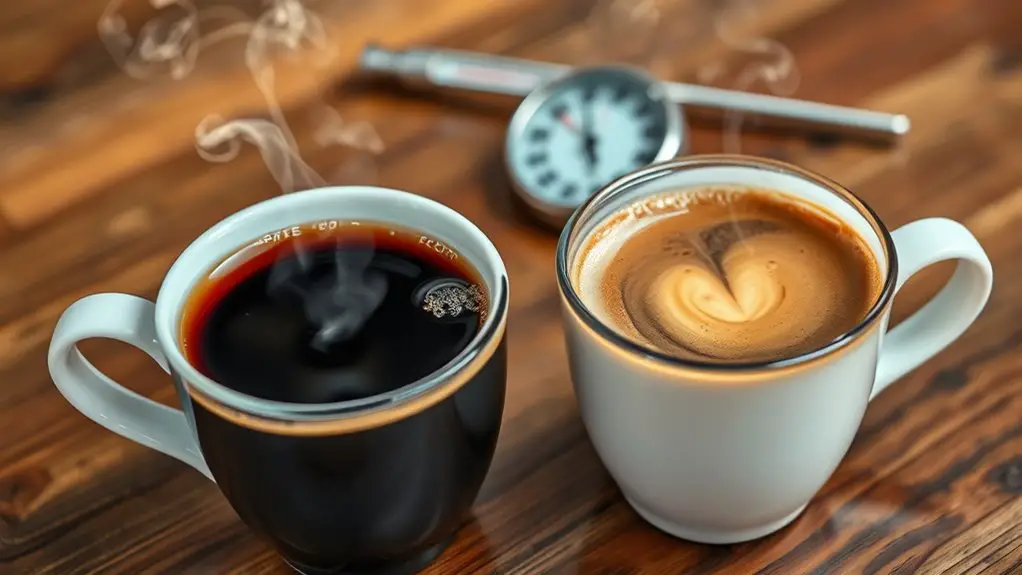Water temperature plays an essential role in coffee strength by influencing the extraction of flavor compounds. When you brew between 195°F and 205°F, you guarantee ideal solubility for a balanced taste. Lower temperatures can lead to under-extraction, resulting in a weak flavor, while higher temperatures risk over-extraction, causing bitterness and burnt notes. By fine-tuning your brewing temperature, you can enhance flavor and body. Discovering the right range can bring out the best in your coffee experience.
The Science of Coffee Extraction
When you brew coffee, the process of extraction is vital to achieving the desired flavor profile. Understanding coffee solubility is key, as it dictates how well flavor compounds dissolve in water. During extraction, various compounds release at different rates, influenced by factors like grind size and brewing time. The extraction dynamics determine which flavors dominate your cup; over-extraction can lead to bitterness, while under-extraction results in a sour taste. Striking the right balance is essential for ideal flavor. By controlling variables such as grind and brew duration, you can manipulate coffee solubility, enhancing or altering the final taste. Mastering these principles empowers you to create a brew that reflects your personal preferences and liberates your coffee experience. Additionally, knowing the solubility of coffee compounds can help you better understand how different brewing methods affect the extraction process.
Optimal Water Temperature Range
The temperature of the water you use has a significant impact on the extraction process and, consequently, the strength and flavor of your coffee. To achieve the best results, aim for an ideal water temperature range between 195°F to 205°F (90°C to 96°C). This range allows for effective extraction without compromising water quality.
| Brew Time (minutes) | Water Temperature (°F) |
|---|---|
| 4 | 195 |
| 3 | 200 |
| 2 | 205 |
Brewing within this temperature window guarantees that you extract the desired flavors and aromas efficiently. Remember, too low a temperature can lead to under-extraction, while too high can cause bitterness.
Effects of High Water Temperatures
High water temperatures, particularly those exceeding 205°F (96°C), can considerably alter the flavor profile and overall strength of your coffee. When water's too hot, it often leads to over extraction, pulling out undesirable compounds. This can result in:
- Burnt flavors that mask the coffee's natural notes
- Astringency that overwhelms the palate
- A thinner body that lacks richness
- An unpleasant aftertaste that lingers
These changes can detract from the intended experience of your brew. Finding the right balance is vital, as high temperatures can quickly ruin the delicate flavors you seek. As a result, it is important to monitor your brewing temperature to maintain the integrity of your coffee and enjoy its full potential without the harsh effects of excessive heat.
Consequences of Low Water Temperatures
Low water temperatures, particularly those below 195°F (90°C), can also greatly impact the strength and flavor of your coffee. When brewing at these lower temperatures, you might notice a diluted flavor profile that lacks the complexity and richness you expect. The extraction process slows down, resulting in under-extraction of essential oils and compounds, which are vital for a balanced cup. While cold brew can be delicious, it relies on extended steeping times to compensate for lower temperatures. If you're not aiming for a cold brew, using water that's too cool can lead to a flat, lifeless cup. Ultimately, understanding these consequences helps you take control of your brewing process, ensuring you enjoy the freedom of a robust and flavorful cup.
Finding Your Perfect Brewing Temperature
How can you determine the ideal brewing temperature for your coffee? It ultimately hinges on your chosen brewing methods and personal preferences. Here are some key considerations:
- Experimentation: Try different temperatures between 195°F to 205°F to find your sweet spot.
- Taste Testing: Brew multiple cups at varying temps, noting flavor nuances and strengths.
- Brewing Method: Different methods like French press or pour-over may require slight temperature adjustments for best extraction.
- Bean Type: Consider the roast level; lighter roasts often benefit from slightly higher temperatures.
Additionally, maintaining the right internal temperature during brewing can enhance extraction and flavor.
Finding the right brewing temperature is a journey of exploration, allowing you to tailor your coffee experience to your unique palate. Embrace the freedom to experiment and discover what truly resonates with you.
Frequently Asked Questions
Does Water Temperature Affect Caffeine Content in Coffee?
When brewing coffee, think of water temperature as the maestro conducting an orchestra. It markedly influences caffeine extraction and other brewing variables. Higher temperatures often yield more caffeine, so adjust your water for a bolder cup.
Can I Use Cold Brew Coffee With Hot Water?
You can use cold brew coffee with hot water, but be mindful that adding hot water may dilute the coffee's flavor and strength. Experiment to find your preferred balance between warmth and taste.
How Does Altitude Impact Water Temperature for Brewing?
Ever brewed coffee at the top of a mountain? Altitude effects can drastically alter water temperature, impacting your brewing techniques. Higher elevations mean lower boiling points, so you've gotta adjust your approach for perfect flavor extraction!
What Equipment Is Best for Maintaining Water Temperature?
To maintain temperature stability, consider using a temperature-controlled kettle or an espresso machine with precise settings. These tools enhance various brewing methods, ensuring consistent results and allowing you to explore coffee's full flavor potential.
Does the Type of Coffee Bean Influence Optimal Water Temperature?
You'll find that the bean's origin and roast level shape its flavor profile, influencing ideal water temperature. A light roast from Ethiopia might thrive at a lower temperature, while a dark Brazilian bean prefers hotter water for extraction.
